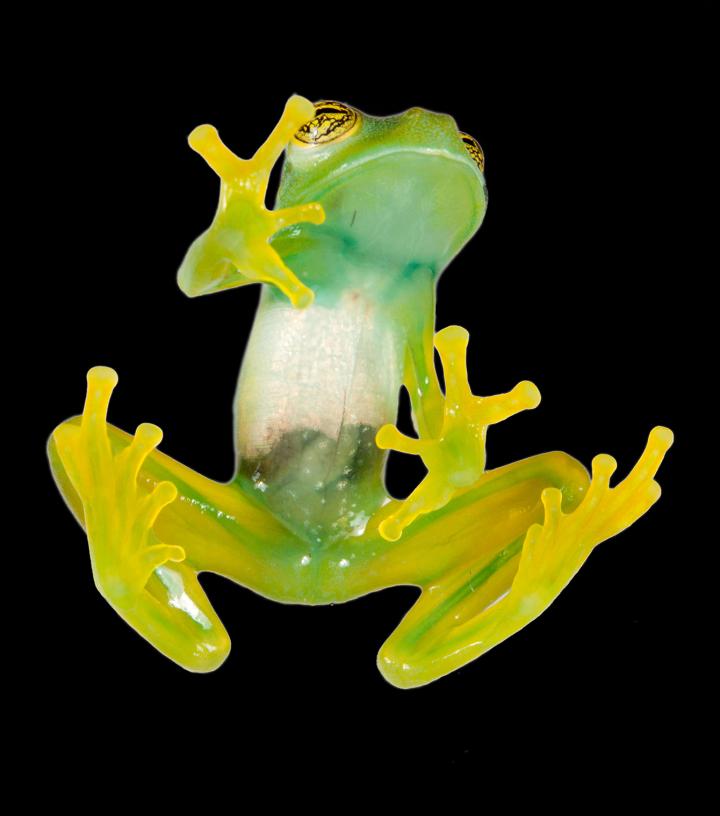Biochemical workaround makes pigment that tunes light to the exact shade of a green leaf

Credit: Santiago R. Ron
DURHAM, N.C. — Frogs and toads are green for a very good reason – it makes them harder to see in their leafy environments. Good camouflage allows them to eat and not be eaten. But not all frogs have arrived at this life-saving greenness in the same way.
Most of these animals rely on color-controlling structures in their skin called chromatophores that use crystals to bend light to specific colors and make them appear green. But there are hundreds of species of frogs and toads that have nearly translucent skin and very few chromatophores.
Their greenness, which can be found deep in their lymphatic fluid, soft tissues and even bones, comes from a clever biochemical workaround that combines a normally virus-fighting type of protein with a toxic byproduct of blood breakdown.
The finding, by post-doctoral researcher Carlos Taboada at Duke University, solves a few longstanding mysteries about these frogs and shows how the necessity of survival can be very inventive indeed. It appears the week of July 13 in the Proceedings of the National Academy of Sciences.
Scientists have long grappled with the fact that many of these frogs contain very high levels of bile pigment called biliverdin that is a byproduct of breaking apart old red blood cells. This pigment is normally considered a toxin to be filtered out in the liver and excreted as quickly as possible. But these frogs are found to carry four times as much biliverdin as even the sickest human with liver disease, and 200 times as much as their chromatophore-equipped frog cousins.
To understand the biochemistry better, the researchers focused on one species, Boana punctata, the polka-dot treefrog of South America. From it, they isolated a protein they’re calling BBS (biliverdin-binding serpin), which is part of a superfamily of protease inhibitors, the proteins that normally step in the way of viral replication and detoxify enzymes.
When you see something green, its color really should be called ‘everything but green,’ because it is soaking up all the colors of incoming light except for green. The color we see is the frequency of light it does not absorb that bounces back to our eyes.
Biliverdin by itself would appear to be somewhat greenish, as sometimes seen in an old bruise, but the researchers found that a bound serpin, BBS, stretches out biliverdin’s helical shape to fine-tune its light absorbance, making it more cyan, a blue-green. Cyan, added to some other yellow pigments scattered in the skin, bounces back just the right shade of green. It also makes biliverdin less toxic as well, apparently.
“This new protein has the same spectroscopic properties or light absorption properties as some plant pigments,” said Taboada, who began the work in Argentina, Ecuador and Brazil and completed it at Duke. “The light properties are very similar to what we see, for example, in some plant proteins called phytochromes. But here we have a completely different protein.”
It’s a clever adaptation of existing biochemistry that normally serves other functions in vertebrates. Taboada said this innovation has evolved more than 40 times across 11 different families, most of them treefrogs. The adaptation happened again and again in far-flung Madagascar, South America and Southeast Asia.
“So this is a convergence in evolution,” Taboada said. “Being arboreal (living in trees), they developed a different way to make their coloration.” Their through-and-through greenness ensures good camouflage on foliage, even in near-infrared light.
“This shows how natural selection can co-opt proteins for just about any purpose,” said Sönke Johnsen, a professor of biology at Duke and coauthor on the paper. “Biliverdin is a bile pigment that would normally be excreted from the body because of its potential for harm, but here it is in spectacular concentrations precisely because it’s also useful as a green pigment.”
“In other words, Kermit has jaundice,” Johnsen said.
Having earlier discovered that many species of frogs reflect fluorescent wavelengths – essentially glowing in the dark – Taboada is now working with engineers at Duke’s Pratt School of Engineering to shine precisely tuned lasers at frogs to learn more about their coloration.
###
“This paper is a tour de force reach between the worlds of molecular biology, biochemistry, and ecology,” Johnsen said.
CITATION: “Multiple Origins of Green Coloration in Frogs Mediated by a Novel Biliverdin-Binding Serpin,” Carlos Taboada, Andres E. Brunetti, Mariana L. Lyra, Robert R. Fitak, Ana Faigon, Santiago R. Ron, Maria G. Lagorio, Célio F. B. Haddad, Norberto P. Lopes, Sönke Johnsen, Julian Faivovich, Lucia B. Chemes, Sara E. Bari. Proceedings of the National Academy of Sciences, July 13, 2020. DOI: 10.1073/pnas.2006771117
Media Contact
Karl Leif Bates
[email protected]
Original Source
https:/
Related Journal Article
http://dx.




